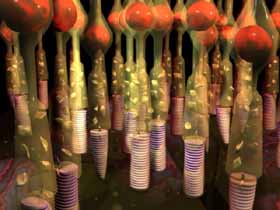
PHOTORECEPTORS

There are a great variety of light detectors in the
animal kingdom from simple clusters of cells that detect only the
direction and intensity of light to complex organs that form images.
Despite their many differences, all photoreceptors contain pigment
molecules that absorb light.
Vision is possible due to the absorption of light by
photoreceptor cells on the retina of the
eye. These photoreceptive cells are sensitive to light in the region
300-850nm making this the visual region of the spectrum.

Vertebrates have two kinds of photoreceptor cells
called rods and cones
due to their distinctive shapes. Rods and cones account for 70% of all
sensory receptors in the body thus showing the importance of the eyes.
Rods are
more sensitive to light so will function in dim light but do not
distinguish colour. They enable us to see at night but only in black and
white.
The
photoreceptive rods
and cones are arranged in such a way as to produce the best possible combination
of night and day vision.
![]()
![]()
![]()
![]()
![]()
![]()
![]()
![]()
![]()
![]()
![]()
![]()

A graphic close-up of photoreceptors. (Rods and cone cells)